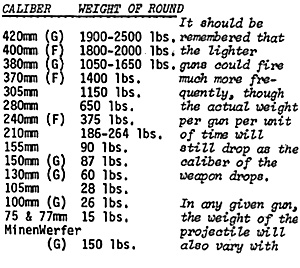The Super-Heavy Howitzers (mortars) were a strictly German invention, with only a few examples made by the Allies. They were based on the German recognition that they would face fortifications wherever they went, and were designed as Fort-destroyers. They were successful in that role, but were called on often to destroy trenches and "pillboxes" because of their phenominal accuracy - the concussive effect of their heavy shells was exceptional for this purpose also.
Present at Verdun were thirteen "Gamma-M" 420mm Howitzers and seventeen 305mm "Beta Guns" of Austrian manufacture; the guns were refered to as "Berthas" and "Emmas".
The Railroad Guns were most often naval pieces on rail mountings, although the French used rail mountings for some of their older heavy howitzers as well. The larger calibers could be used as fort destroyers, and were so used by the French who lacked Super-Heavy Howitzers. The Germans used theirs primarily as interdiction weapons, attacking targets far behind the lines. The Germans has two 380mm Guns (called "Max E.") at Verdun, their range varied from 38 to 45,000 yds depending on the projectile. The French had larger numbers of railroad pieces, ranging from 12" (305mm) guns up to two 400m Schneider-Creusot Guns which were brand new.
Medium Guns were the long range 130s and 150s (German) and 155s (French). They had two main functions; long-range interdiction of troops and supplies, and their primary function of engaging the enemy artillery units (counter-battery fire, except that the term in the game has a different meaning).
In addition, the German 130s were used for a kind of large-scale sniping, because their muzzle velocity was so high that the shell and the sound arrived almost simultaneously, giving no warning; because of this trait they were called "whizz-bang" guns. Once again, all the German guns were of modern manufacture, while the newer French 155s were levened with ancient pieces having no recoil systems, severely limiting the rate of fire.
Medium and Heavy Howitzers were the troop killers; theirs was the job of primary trench bombardment, and they inflicted most of the casualties, While the French made do with a mixture of many types and vintages of 155s, combined with a scattering of older heavier pieces, many stripped from fortifications, and just a few newer 220 and, 240mm pieces, the Germans were relatively lavishly equipped here. They had modern 150mm howitzers which would go relatively unchanged into WW II, and had on hand 128 superlative 210mm howitzers, which were unmatched by the French.
Also present were some modern 280mm howitzers, a cross between the 210s and the Super-heavies. The shortage of medium and heavy howitzers was the weakest point of the French artillery system, and reflected the initial French viewpoint that their famous "soixante-quinze" (75) could do all the jobs on the battlefield. The starting deficiency in heavy weapons would not be really made up until 1917.
Light Field Guns constituted the one area where the French excelled. Their 75mm M1898 was unmatched in it's day, even saw service in WW II. The German 77mm gun of the time was limited in range by it's construction, though later models would be improved in this respect. The French 75 was called on to do all kinds of artillery jobs, and it even had a system of discs to give it a trajectory like a howitzer. While it was superlative at counter-battery fire on attacking troops, it's capabilities were not up to trench bombardment.
The Germans were also using at this time an excellent weapon in the brand new (M1914) 100mm Gun. This could far outclass the 75 while being almost as mobile, but it was hampered in its employment because the artillery doctrinists were not sure just how to use it.
Mine-Throwers - This was another German invention, which the British were to turn into the modern Mortar. The Germans had 152 special Giant "Minenwerfers" at Verdun. They had a very limited range (600 yds. or less) but fired a very heavy projectile which had an impact much more powerful than its size would seem to indicate because the projectile was almost wholly explosive. These minethrowers were used in a kind of "intermittent barrage" -- the artillery would fire and then cease, and the close-range minethrowers would then be right on the scene to eliminate any remaining pockets of resistance. Once the front began shifting into open ground, the minethrowers became less useful because their short range left them very vulnerable to enemy fire.
 Shell Weights - As the VERDUN artillery CRT indicates, casualties were usually
dependent on the tonnage dropped on a given area; accordingly, below are some
of the shell weights of the various calibers of weapons:
Shell Weights - As the VERDUN artillery CRT indicates, casualties were usually
dependent on the tonnage dropped on a given area; accordingly, below are some
of the shell weights of the various calibers of weapons:
In any given gun, the weight of the projectile will also vary with the type of projectile - shrapnel shells are the heaviest, then H.E.-shrapnel mixes then H.E., and Gas shell are the lightest. Some guns had lighter projectiles which they could fire to gain greater range; it generally meant a small shell and more room for the propellant charge.
During the whole (10 month) battle, over 45 million of these shells were fired by both sides, and at the peak of the initial bombardment, 100,000 were falling each hour, a concentration unequalled in any other battle.
Verdun: The Situation
Verdun Game Variants
- Introduction
Initial Order of Battle
Forts
Artillery CRT Variation
Observation
Use of the Artillery Shell Table
Back to Table of Contents -- Panzerfaust #67
To Panzerfaust/Campaign List of Issues
Back to MagWeb Master Magazine List
© Copyright 1975 by Donald S. Lowry
This article appears in MagWeb (Magazine Web) on the Internet World Wide Web. Other military history articles and gaming articles are available at http://www.magweb.com